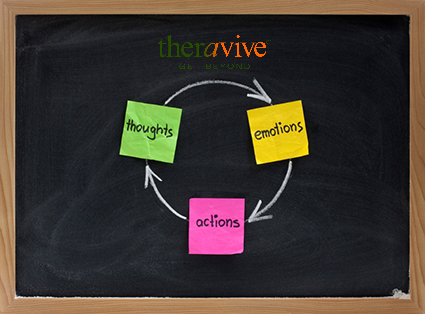 Understanding and working with our emotions is the root of change and essential to everything we do. Working with our emotions goes beyond just asking, “what do you feel?” It’s about listening to our emotions, understanding what they are communicating to us and using that information to help us solve problems. The ability to tolerate and express emotion is not only connected to greater mental health, but to greater physical health as well.
Understanding and working with our emotions is the root of change and essential to everything we do. Working with our emotions goes beyond just asking, “what do you feel?” It’s about listening to our emotions, understanding what they are communicating to us and using that information to help us solve problems. The ability to tolerate and express emotion is not only connected to greater mental health, but to greater physical health as well.
Connecting to and understanding your emotions is important for many different reasons!
Our emotions are a messaging system, communicating important information to us all the time. We can check in and ask ourselves, what am I feeling, listen to get the message from the emotion and decide what action needs to be taken. Emotions tell us when we are in danger, when boundaries have been crossed, when we need to let go or get rid of something. Being aware of emotions helps us in making decisions, resolving problems, and responding to situation and events.
Emotions motivate our behavior. For example, if you are crossing the street and you see a car run a red light in your direction, you will likely perceive danger, get anxious, and run to get out of the way. Emotions help us communicate with people. If you feel a boundary is being violated, your feeling of anger may prompt you to say no. Emotions also help us to recognize what others are feeling. Emotions communicate to us what we like and do not like. This includes a variety of information such as hobbies, people, work, interests, food, how we prefer to be treated, our values, etc.
So why is it so hard to work with our emotions?
Many of use never received training in working with our emotions. Rather we were told “man up”, “girls don’t get angry,” “boys don’t cry,” and so forth. Very well meaning caregivers taught us that emotions were to be avoided. Culturally, we have an allergy to emotions. There are endless books published on the pursuit of happiness. We are constantly seeking to avoid the uncomfortable. We look for solutions on how to “fix” our problems and make them go away. When we’re in pain, others give advice on how to fix vs. validating how we feel. We’re simply not skilled in working with our emotions. In many cases, our brains have learned to respond to our emotions as a threat to be avoided.
Emotions are part of our limbic system in the brain, which is different from our thinking system. When our brain senses danger (our own thoughts and emotions can be sensed as danger), an alert system goes out much more rapidly than our thinking brain can process. In these cases an automatic emotional response happens before we can do anything to stop it. An example might be reacting strongly when someone cuts you off, or jumping back in fear when something is thrown at you. When we have learned to perceive our own emotions or those of others as dangerous, we can have this same reactive response to our own internal sensations and emotions. This can create problematic reactions in our lives!
A Few Points About Emotions
All feelings are real. They are not always true in terms of the feedback that they give us about the current situation. For example, you could hear a loud noise and experience fear. Yet, when you explore further, you could find there is nothing to fear. Emotions aren’t right or wrong, good or bad, positive or negative. Emotions can be thought of as unpleasant or pleasant. Emotions feel problematic when they’re judged to be the wrong ones, when we overreact or underreact, or we get stuck in one. The goal with all emotions is to make space for them and to let them flow. When this happens, emotions come and go like rolling waves.
Working with Our Emotions
So how do we become more skilled at understanding our emotions? These three steps will help you to tune in and get the message your emotions are trying to send you. This is not an easy process. It takes practice!
1. Become Aware of Your Emotions
To most accurately identify what you are feeling, you will want to focus on your internal, physical sensations. Emotions exist in the body and show up in the form of physical sensations such as sadness in your eyes or excitement in your stomach. Focus on internal sensations in your body and let them be without trying to change them. Just observe and allow them to be there. When we repress, stuff, or avoid unpleasant emotions they get stuck. Observing your emotion without resistance allows it to flow. Separate the feeling from the verdict. The verdict is the judgment (failure); the feeling is the feeling (pain in my stomach). Remember, allowing our emotions, will allow them to flow and not become stuck.
2. Claim and validate your emotions.
Naming your emotions activates the logical brain, which helps balance the emotional side. Be careful though not to get caught up in thoughts, which will disconnect you from your body/emotions. Watch out for analyzing, assessing, or judging. Accept that the emotion is present for a good reason. Validate that you are feeling this way and that it’s hard.
3. Identify what you need and choose the behavior:
Check in and ask yourself if there is anything that needs to be done. For example, if you are feeling angry, it could be telling you to enforce a boundary with someone. If you are feeling restless, you might want to get up and move around to release some energy. If you are feeling sad or hurt, you may want some comfort, connection or soothing. Ask yourself what might be helpful and see if anything comes up for you.
TRAUMA and Emotions
When we experience an emotion, we can access our neocortex to help balance our emotions. This is what we do when we name an emotion. However, when we have experienced trauma or intense stress, we go the low road, which involves a shutting down of the higher process of the mind and leaves the individual in a state of intense emotion and impulsive reactions. The limbic system becomes flooded. Past experiences can impact this activation.
When this happens, grounding techniques are needed to restore safety before emotion can be processed. Grounding reduces fear.
What to Do When You’re Stuck in an Emotion
1. Get safe. You have to be safe in order to self-soothe, communicate and connect. When we’re too scared, we freeze. We’re stuck. We can’t think or understand what another person is saying. We’re listening with the intention of protecting ourselves.
2. Move: the first thing to do when you realize you’re emotionally stuck is physically move. Stretch or go outside for a walk. The goal is to become aware of your surroundings to get grounded and safe. Smell the fresh air, touch the leaves, see the colors, listen to birds. Feel your fingers, wiggle your toes. Focus on your physical sensations instead of the unpleasant thoughts you are having. Moving around gets more blood and oxygen to your brain, which helps to think instead of just feel.
3. Breathe: deep breathing also helps your heart pump blood and oxygen to the brain and relax your body. Regulates between emotional and thinking brain. Once you physically relax, you start to feel emotionally safe.

Here are some additional grounding exercises to try when you are flooded or stuck in a difficult emotion:
Mental Grounding
· Describe your environment in detail, using all your senses – for example, “The walls are white, there are five pink chairs, there is a wooden bookshelf against the wall….” Describe objects, sounds, textures, colors, smells, shapes, numbers and temperature. You can do this anywhere, For example, on the subway: “I’m on the subway. I’ll see the river soon. Those are the windows, this is the bench, the metal bar is silver. The subway map has four colors.
· Play a “categories” game with yourself. Try to think of “types of dogs”, “jazz musicians”, “States that begin with an “A””, “cars”, “TV shows”, “writers”, “sports”, “songs” or “cities”.
· Do an age progression. If you have regressed to a younger age (e.g. 8 years old), you can slowly work your way back up (e.g. “I’m now 9, I’m now 10, I’m now 11…..”) until you are back to your current age.
· Describe an everyday activity in great detail. For example, describe a meal that you cook (e.g. “First I peel the potatoes, and then cut them into quarters, then I boil the water, then I make a herb marinade of oregano, basil, garlic and olive oil…..”).
· Imagine. Use an image: Glide along on skates away from your pain; change the TV channel to get to a better show; think of a wall as a buffer between you and your pain.
· Say a safety statement. “My name is _____________. I am safe right now. I am in the present, not the past. I am located in ______________. The date is ___________.
· Read something, saying each word to yourself. Or read each letter backward so that you focus on the letters and not the meaning of the words.
· Use humor. Think of something funny to jolt yourself out of your mood.
· Count to 10 or say the alphabet. Very s…… l….. o….. w….. .l…… y..
Physical Grounding
· Run cool or warm water over your hands.
· Grab tightly onto the chair as hard as you can.
· Touch various objects around you. A pen, keys, your clothing, the table, the walls. Notice textures, colors, materials, weight, temperature. Compare objects you touch – is one colder? Lighter?
· Dig your heels into the floor – Literally “grounding” them! Notice the tension centered in your heels as you do this. Remind yourself that you are connected to the ground.
· Carry a grounding object in your pocket – a small object (a small rock, a ring, a piece of cloth or yarn) that you can touch when you feel triggered.
· Jump up and down
· Notice your body – the weight of your body in the chair, wiggling your toes in your socks, the feel of your back against the chair. You are connected to the world.
· Stretch – extend your fingers, arms, or legs as far as you can, roll your head around.
· Clench and release your fists.
· Walk slowly, noticing each footstep – saying, “left” or “right” with each step.
· Eat something and describe the flavors – in detail to yourself.
· Focus on your breathing – noticing each inhale and exhale. Repeat a pleasant word to yourself on each inhale (e.g. a favorite color or a soothing word such as “safe” or “easy”).
Soothing Grounding
· Say kind statements – as if you were talking to a small child – for example “You are a good person going through a hard time. You’ll get through this.”
· Think of favorites – Think of your favorite color, animal, season, food, time of day, TV show.
· Picture people you care about – e.g. your children), and look at photographs of them
· Remember the words to an inspiring song, quotation or poem that makes you feel better.
· Remember a safe place. Describe a place that you find very soothing (perhaps the beach or mountains, or a favorite room. Focus on everything about that place – sounds, colors, shapes, objects, and textures.
· Say a coping statement – “I can handle this”, “The feeling will pass”.
· Plan a safe treat for yourself – such as a piece of candy, a nice dinner, or a warm bath.
· Think of the things that you are looking forward to in the next week – perhaps time with a friend, going to a movie, or going on a hike.
Therapy Can Help You Cope with Difficult Emotions
Practice checking in with your emotions on a regular basis. This will help you feel better, improve your relationships and strengthen your immune system. A therapist can help you work with difficult, overwhelming emotions and heal reactivity. Contact a therapist in Houston at Eddins Counseling Group by calling 832-209-2222 or schedule an appointment online. Online therapy options also available.
About the Author
 Eddins Counseling Group, LPC
Eddins Counseling Group, LPCSometimes it can seem like everyone but you has it all figured out. The reality is that it just seems this way. Everyone faces struggles in their lives. When you feel stuck, dissatisfied, and overwhelmed or just don’t know what to do to feel better an outside perspective can help you get back on track. We are a team of Houston therapists, relationship counselors, and career counselors. Online therapy and career counseling via phone or video conferencing is also available.
Office Location:
5225 Katy Freeway, Suite 103
Houston, Texas
77007
United States
Phone: 8325592622
Contact Eddins Counseling Group
Eddins Counseling Group has a clinical practice in Houston, TX
Professional Website:
www.eddinscounseling.com